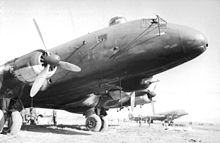Junkers Ju 290
Derived from the Ju 90 airliner, it was a dedicated military heavy transport developed on behalf of the Luftwaffe as a wartime replacement for Focke-Wulf Fw 200 Condor.
In comparison to the standard Ju 90, it had a lengthened fuselage, more powerful engines, and a Trapoklappe - a hydraulically operated rear loading ramp.
While originally designed for the heavy transport role, an urgent requirement for a long-range maritime reconnaissance aircraft led the Ju 290 being adapted to fulfil this mission as well.
The Junkers 290 was developed directly from the Ju 90 airliner, versions of which had been evaluated for military purposes,[3][4] and was intended to replace the Luftwaffe's relatively slow Focke-Wulf Fw 200 Condor, which by 1942 was proving to be increasingly vulnerable when confronted with Royal Air Force aircraft.
In comparison with the Ju 90, it featured a lengthened fuselage, more powerful engines, and a Trapoklappe - a hydraulically operated rear loading ramp.
[10] Three A-1 aircraft were converted to A-2 standard while still on the assembly line; the range of modifications necessary, which included the installation of strong defensive armament, slowed production considerably.
[citation needed] The Ju 290A-3 followed shortly after the A-2, the primary difference of this variant was the fitting of a low-drag rear dorsal turret along with more powerful BMW 801D engines, capable of producing up to 1,300 kW (1,700 hp).
[citation needed] The Ju 290A-5 featured a further increase in armour protection and the fitting of dual 13mm MG 131 in a rear-facing position in the gondola.
[20][19] Several Ju 290s were lost in action during early 1943, including one on the Eastern Front while participating in the Stalingrad Airlift and two more while flying supplies to German forces in Tunisia.
[citation needed] A special long-range reconnaissance group, FAGr 5 (Fernaufklärungsgruppe 5), was formed on 1 July 1943 and, during the late summer of 1943, three of the new Ju 290A-2s were delivered to its 1 Staffel, which became operational at Mont-de-Marsan near Bordeaux on 15 October of that year.
[13] They flew their first operational missions in November 1943, shadowing Allied convoys in cooperation with U-boats, often remaining airborne for up to 18 hours at a time.
11 Ju 290A-5s with increased armour, heavier armament and self-sealing fuel tanks were delivered to FAGr 5 early in 1944, as were around 12 of the Ju 290A-7 version; the A-7 could carry three Hs 293 glide bombs or Fritz X armoured, anti-warship remote controlled guided bombs when fitted with the FuG 203 Kehl radio guidance system for them, and featured a redesigned nose section which combined a 20 mm cannon installation with the FuG 200 radar aerial array.
[citation needed] Towards the end of 1943, Admiral Dönitz demanded that the entire output of Ju 290s be made available for support of the German U-boat campaign.
Even though both Hitler and Dönitz demanded an increase, the Luftwaffe General Staff declared it was unable to assign any more for naval reconnaissance purposes.
[citation needed] In the spring of 1944, after Albert Speer had taken over the direction of air armaments, the Oberkommando der Luftwaffe (Luftwaffe High Command) boldly announced that production of the Ju 290 was to be suspended despite it being urgently needed for maritime reconnaissance; suspending production meant that resources could instead be diverted to building fighters.
[21] On 26 May 1944, shortly after daybreak, a Hawker Sea Hurricane, piloted by Sub-lieutenant Burgham from the escort carrier HMS Nairana protecting a convoy, shot down Ju 290 (9V+FK) of FAGr 5 over the Bay of Biscay.
[22][23] As the Battle of the Atlantic swung irrevocably in favour of the Allies with the loss by the Germans of French bases in August 1944, FAGr 5 withdrew eastwards and the remaining Ju 290s were reassigned to transport duties, including service with KG 200, where they were used to drop agents behind enemy lines and other special missions.
[24][25] Ju 290 A-5, works number 0178, D-AITR, Bayern of Luft Hansa flew to Barcelona on 5 April 1945, piloted by Captain Sluzalek.
[26] Following the invasion of the Soviet Union in June 1941, plans were made to connect Germany and Japan by air using Luftwaffe aircraft modified for very long range flights.
Nautsi, near Lake Inari in the north of Finland, was finally selected as the optimum starting point for a great circle route along the Arctic Ocean then across eastern Siberia, to refuel in Manchuria before completing the flight to Japan.
In late 1942 Field Marshal Milch ordered that the possibility of increasing the fuel capacity of the Ju 290 to enable it to perform the Amerika Bomber mission itself.
The draw backs were twofold, chiefly being that the initial rate of climb would be very poor, and that the fully loaded airplane could only operate out of two airfields in France.
[39] During May 1942, engineers at Junkers had done calculations to investigate the possibility of refueling the Ju 390 in flight from a Ju 290,[40] something that had been proposed earlier for the same sort of duty to support the initial high-altitude version of the rival Heinkel He 177A, the proposed A-2 subtype – with such capability, the range of the He 177A-2 would have been extendable to some 9,500 km (5,900 mi) of total flight distance.




